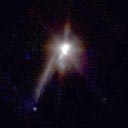
| Bad Astronomy |
|
|
|
BA Blog
|
|
Q & BA
|
|
Bulletin Board
|
| Media |
|
|
|
Bitesize Astronomy
|
|
Bad Astro Store
|
|
Mad Science
|
|
Fun Stuff
|
| Site Info |
|
|
|
Links
|
| RELATED SITES |
| - Universe Today |
| - APOD |
| - The Nine Planets |
| - Mystery Investigators |
| - Slacker Astronomy |
| - Skepticality |
Buy My Stuff

Keep Bad Astronomy close to your heart, and help make me
filthy rich. Hey, it's either this or one of those really
irritating PayPal donation buttons here.
Is this a planet?
Week of June 1, 1998
 Does this picture show the first direct evidence of a
planet orbiting a sun not our own? The image was taken a few months
ago
by an astronomer named Susan Terebey using the
NICMOS camera on board the
Hubble Space Telescope. NICMOS is sensitive to infrared
light, and the image is a combination of three different
infrared wavelength pictures, just like a normal color picture
is a combination of red, green and blue pictures.
Does this picture show the first direct evidence of a
planet orbiting a sun not our own? The image was taken a few months
ago
by an astronomer named Susan Terebey using the
NICMOS camera on board the
Hubble Space Telescope. NICMOS is sensitive to infrared
light, and the image is a combination of three different
infrared wavelength pictures, just like a normal color picture
is a combination of red, green and blue pictures.
The large blob near the top of the image is actually two stars orbiting one another. They are very young stars, so young in fact that they are still enshrouded in the dust and gas from which they formed. A visible light image would just show the dust and gas, but infrared light can travel through such material and show us what is underneath.
The interest has been generated by the point-like object below the binary stars. Judging by how bright it is in the separate images, Terebey's team has determined that it is a very low mass object, too low in fact to be a star! It appears to have only a few times the mass of Jupiter. Is it a planet? It might just be a background star, much farther away than the binary but coincidentally placed near them in our field of view. This is unlikely, argues Terebey, since there appears to be a filament of light connecting the binary to the object. This implies that they are somehow associated with each other.
As theory goes, it is possible that planets around binary stars (or even systems with more than two stars) can be ejected from the system, literally thrown off to wander through space. This may actually occur quite often in environments like star clusters, where gravitation interactions between stars is common. The object in the picture may then be a planet that was orbiting the binary but got ejected from the system in much the same way NASA uses the planets in our solar system to influence the paths of probes like Voyager and Cassini. Terebey argues that the object in the image is just such an ejected planet, and the filament of light is the tunnel it plowed through all the gas and dust in the area as it moves away.
Whether this object is really a planet or not remains to be seen. I know from my own research that using the methods Terebey used, it's very difficult to get a good estimate of the mass. Still, the object appears to be 'way below the mass limit for a star. Her team hopes soon to use some large ground-based telescopes to get spectra of the object to see if it looks like a planet that way too. Time will tell.
|
|
| THE PANTRY: ARCHIVE OF BITESIZE SNACKS |
|
|
| Subscribe to the Bad Astronomy Newsletter! |
| Talk about Bad Astronomy on the BA Bulletin Board! |